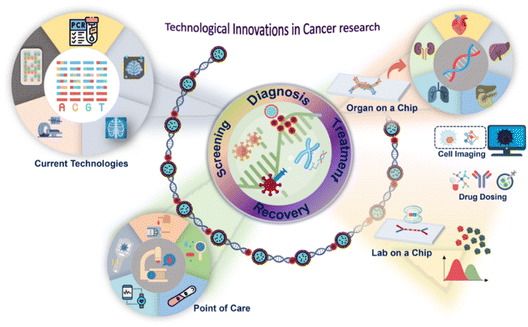 Open Access Article
Open Access ArticlePerspective of point-of-care sensing systems in cancer management
Kamil Reza
Khondakar
 *a,
M. S.
Anwar
b,
Hirak
Mazumdar
a and
Ajeet
Kaushik
*a,
M. S.
Anwar
b,
Hirak
Mazumdar
a and
Ajeet
Kaushik
 c
c
aSchool of Technology, Woxsen University, Telangana 502345, India. E-mail: kamilreza@gmail.com; kamil.reza@woxsen.edu.in
bDepartment of Kulliyat, Aligarh Muslim University, Aligarh, India
cNano Biotech Laboratory, Department of Environmental Engineering, Florida Polytechnic University, Lakeland, FL 33805-8531, USA
First published on 28th September 2023
Abstract
Globally, the number of cancer cases is rising, with no difference between rich and undeveloped countries. Although affluent nations have made great improvements in the quality of cancer detection and treatment, many nations still face serious obstacles. Basic cancer screening facilities and industry-standard cancer management tools are still inaccessible in these nations. Currently, there are many challenges in the field of cancer research, from the earliest screening procedures to dealing with cancer recurrence. These difficulties highlight the urgent requirement for quick screening tools for better cancer management and a reduction in the mortality rate. In this review, we focus on early-stage disease management, quicker analysis of patient samples, multiple diagnostics for better recovery, and continuous monitoring to avoid disease recurrence and future possibilities. Point of care (POC) technology has been introduced in the health sector to reduce the mortality rate of any disease by detecting early symptoms. Current cancer treatment technology has reduced the mortality rate, but early detection, early diagnosis, and frequent monitoring through various POC systems can provide better survival of the patient and reduce the death rate. Lab on a chip (LOC), organ on a chip (OOC), 3D printing, wearable sensors, internet of things (IoT), artificial intelligence (AI), and next-generation sequencing can provide a smart and digital way to manage cancer by monitoring an individual's physiological and mental biometrics.
Introduction
Cancer occurs due to the uncontrolled growth of cells and affects body functions/organs, leading to serious illness and eventually causing death.1–3 Cancer is a complex disease that progresses in numerous ways.4 Some of the well-known factors which cause cancer are tobacco, infectious-organisms, unhealthy lifestyle, genetic mutations (heredity), alcohol, and immune conditions.5 Therefore, it is a huge challenge for the medical industry or research scientists to design a common platform for screening cancer as well as cancer diagnostics. Researchers are exploring numerous methods for cancer management by developing metal/metal oxide nanosystems for next-generation anti-cancer agents, contrast agents for cancer imaging, biosensors and microfluidics for cancer treatment, etc.6–10Fig. 1 depicts the current approaches for cancer treatment which include radiotherapy, chemotherapy, immunotherapy, gene therapy, nanomedicine, etc. However, some of the major limitations in cancer treatment include no early-stage screening, lack of effective biomarkers, no metastasis treatment, anticancer drugs, immunity, etc.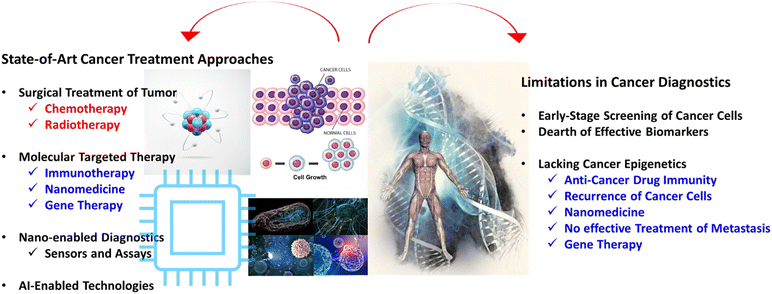 | ||
| Fig. 1 Current approaches for cancer treatment and some of the major limitations in cancer diagnostics. | ||
Early detection and timely diagnosis of cancer can reduce mortality rates. Currently, in hospitals, the average detection time for cancer screening is between 3 to 10 days (liquid biopsy) depending on the complexity of cancer. In most cases, cancer is detected in advanced stages which makes it more difficult for the doctors to cure the patients. Therefore, in this regard, point of care (POC) systems have emerged as a rapid screening tool for better cancer diagnostics.11–13 They can also provide insights into individual health for disease prevention and management as POC can determine the health status of an individual on a daily basis.14 Due to the advancement in technology and its involvement in our daily lives, people are adapting to current digital health systems for the betterment of their health. These devices can also provide rapid diagnosis to remote villages where there is limited laboratory infrastructure and can operate as mobile diagnostics centers for cancer screening.15 However, there are certain challenges when using the POC system to screen and detect cancer.
Even though medical technology has shown great progress in the advanced treatment of cancer stages, it still fails to meet the basic medical facilities required for common people in most underdeveloped countries. Screening, diagnosis, monitoring, and treatment are four basic management policies for any disease diagnostics. Several research groups are working on POC platforms to enhance their sensitivity, and produce inexpensive and multi-function capable technologies for the detection of various cancer biomarkers. Conventional cancer screening and diagnostics instruments/methodologies are complicated and require sophisticated instruments with large processing times for outcomes and trained professionals, which are some of the constraints faced by hospitals. There are two prevalent POC systems for cancer screening: screen printed electrodes (SPE) and paper-based microfluidic analytical devices (μPADs). These two systems have provided a rapid diagnostic approach for cancer detection in limited resource settings. Currently, lab on a chip (LOC), organ on a chip (OOC), 3D printing, wearable sensors, internet of things (IoT), artificial intelligence (AI), etc. are bringing innovations in the medical industry to improve the healthcare sector.16–18 Moreover, cancer immunotherapy and precision medicine have shown auspicious results for cancer treatment.19,20 A combination of immune checkpoint inhibitors with other treatments, investigation of undesirable events in immunotherapy, involvement of personalized nanomedicine and vaccines in clinical trials along with AI for accurate predictions, and CAR-T therapies for solid tumors are some of the breakthroughs in cancer research.21
This review will include a discussion on challenges towards screening, monitoring, and detecting cancer faced by POC platforms. Also, we will briefly go through the development and progress of potential new POC technologies toward cancer management. Specifically in medical resource-limited areas, delayed screening, diagnosis, and treatment usually result in aggravation or even death. It is important to provide insight into dynamic biochemical processes in bio-fluids via continuous, real-time monitoring of biomarkers to recover patients and provide a healthy life.
Current challenges in cancer diagnostics
Cancer is a complicated disease, and it requires various methodologies to unravel the mystery of tumour development and its progression in the human body. Early-stage cancer detection is a big challenge for scientists and medical practitioners. Tumor heterogeneity is a major deadlock for the successful treatment of cancer.22,23 Tumors contain a mixed population of cells characterized by different molecular features and diverse responsivity to therapies which makes it very difficult to diagnose patients. Most of the drugs and treatment strategies are developed based on the homogeneous nature of the tumor population. Therefore, it is crucial to create new treatment tactics such as nanomedicine, organ on a chip, and immunotherapy as precision oncology management processes that are more personalized and community specific. Furthermore, poor prognosis and drug resistance present major inhibitions to combat the recurrence cases. There is a long list of cancers where patients do not show any major symptoms and do not cause any physical pain, irritation, or discomfort in the affected region. The initial stage symptoms in cancer development in the human body are patient dependent as well as cancer phenotype dependent. We discuss below some cancers which do not show any major symptoms as a way to understand the complexity and heterogeneous nature of the tumor microenvironment.No early-stage symptoms are found in prostate cancer. A prostate-specific antigen (PSA) test can confirm the presence of prostate cancer, however, the results are sometimes ambiguous. Lumbreras et al. reported the incidence of false-positive and false-negative results in PSA tests in a general clinical setting.24 They found a high rate of false-positive results (46.6%), resulting in a positive predictive value of 12.7%. Their report also mentioned that patients above 70 years of age were more likely to have a false-positive result than those under 45 years.
Also, there are no obvious symptoms during the onset of ovarian cancer. Therefore, screening for this cancer-type requires an antigen test and ultrasound study which can confirm the presence of ovarian cancer. Similarly, one of the most dangerous and dreadful cancers is pancreatic cancer. This cancer is not detectable until it reaches an advanced stage and high-resolution scanning of the pancreas can detect the disease. The survival rate is very low for this cancer. Therefore, the above-mentioned cancer types have high mortality rates due to the undetectable nature of the disease. So, it is very important for us to develop more sophisticated, ultra-sensitive instruments/technologies for comprehensive screening of the human body to identify the tumor origin. In this regard, POC systems can play a pivotal role as a quick screening tool as they are portable in nature and can provide instant results for quick diagnosis. This would enable early detection, personalized treatment, and enhanced patient management to reduce the mortality rate.
On the other hand, certain types of cancers show apparent signs of the onset of the disease. Some of the well-known symptoms of cancer are depicted below. In liver cancer, the initial-stage of liver cancer involves yellowing of the skin (jaundice), stomach pain, and weakness. The early signs of melanoma cancer include the appearance of abnormally shaped moles, skin darkening, etc. In the case of leukemia cancer, flu-like symptoms, easy bruising, and weakness indicate the onset of the condition. Similarly, the appearance of a lump in the neck and a change in voice might be a possible sign of early-stage thyroid cancer. All the above-mentioned cancers can be detected through liquid biopsy and imaging tests like computer tomography (CT) scans, magnetic resonance imaging (MRI), ultrasound, X-Ray, etc. based on the symptoms of the patient. So early-stage detection, screening, and initial diagnosis can save the lives of millions from cancer death. Therefore, the application of a POC system is beneficial for all types of cancer screening. POC technology can trace the concentration of different biomarkers for diagnostic testing and can speed up the therapeutic time as standard techniques require more processing time for analysis and diagnostics.
Cancer biomarkers
Cancer biomarkers are the biological molecules found in body fluids or tissues that can indicate a normal or abnormal process, or the presence of a condition or disease.25,26 Biomarkers are also being utilized for understanding the disease stages and treatment monitoring. Some well-known biomarkers are proteins, nucleic acids (DNA, RNA), antibodies and peptides, exosomes, etc. Gene expressions are also used as genetic biomarkers detected as sequence variations in germ-line deoxyribonucleic acid (DNA) isolated from blood. Different types of biomarkers are being used for a variety of cancers in different clinical settings, as shown in Table 1.25,27–29| Biomarker | Cancer type | Clinical use | Analysis | Ref. |
|---|---|---|---|---|
| HER2 | Breast | Prognosis, monitoring | Tumor | 25 |
| CA 15-3/CA 27-29 | Breast | Monitoring | Blood | 27 |
| CD 19 | B-cell lymphomas and leukemias | Diagnosis and treatment | Blood and bone marrow | 27 |
| PSA (total) | Prostate | Screening and monitoring | Blood | 28 |
| Urine catecholamines: VMA and HVA | Neuroblastoma | Diagnosis | Urine | 29 |
| KRAS gene mutation | Colorectal cancer and non-small cell lung cancer | Treatment | Tumor | 29 |
| BCL2 gene rearrangement | Lymphomas, leukemias | Diagnosis and planning therapy | Blood, bone marrow or tumor tissue | 25 |
| Nuclear matrix protein 22 | Bladder | Treatment | Urine | 27 |
| CA 125 | Ovarian | Diagnosis, treatment | Blood | 28 |
| CA 19-9 | Pancreatic | Monitoring, treatment | Blood | 29 |
| α-Fetoprotein | Testicular | Diagnosis | Blood | 25 |
| BRCA1 mutation | Breast and ovarian | Screening, | Blood and/or tumor | 27 |
| CEA | Colon | Monitoring | Blood | 28 |
| FGFR2 and FGFR3 gene mutations | Bladder | Treatment | Tumor | 29 |
| FLT3 gene mutations | Acute myeloid leukemia | Treatment | Blood | 27 |
POC systems
A POC system (POC) is a portable device used for the analysis and detection of disease outside a traditional laboratory.15,30 A POC can provide early and rapid screening diagnoses for patients. The recent advancements in nanotechnology and microfluidics have brought a revolution in medical healthcare. Microfluidic systems are the leading emerging technology in medical diagnosis for device advancement with ultra-high sensitivity and selectivity.13,20,31 Thus, combing microfluidic systems with POCs has resulted in efficient, precise, and advanced devices for rapid tracing, monitoring, and diagnosis of cancer. Their small microchannels create a large surface area and high mass transfer kinetics for controllable liquid flow. Moreover, microfluidic technology utilizes very low reagents, fast mixing of fluids, and quick response time for medical analysis. Among the emerging technologies, 3D printers, organ on a chip, wearable sensors, commercial portable devices, and mobile based POC systems are on the market for various cancer management processes. In Fig. 2, we have summarized the technological advancements in cancer research. We depict the current technologies involved in cancer management along with the POC system available and the potential emerging technologies being explored for cancer research. These POC systems have brought radical changes toward personal and rapid detection systems for digital and smarter health system development.SPE and μPADs
Among the current POC systems, SPE has been explored extensively for cancer biomarker detection.32–34 SPE is one of the cheapest ways to achieve onsite analysis and is a rapid testing tool for cancer biomarkers. SPE generally consists of a miniaturized form of 3 electrodes as the working, reference and counter electrodes using conductive substrates like carbon graphite, graphene, etc., and metals (Au, Ag, Pt, etc.). Cancer biomarkers can be easily traced on the electrode surface for onsite detection of cancer providing rapid identification of disease. Crapnell et al. summarized the importance of SPE as the most sought after POC system due to its high reproducibility, good sensitivity, wide ranging substrate availability (paper, polymers, ceramics, metals, etc.), mass production capability and multiple applications.34 They also reported various SPE based electrochemical sensors for the detection of cancer biomarkers. There are reports of SPE based electroanalytical sensors for the detection of various cancer protein biomarkers such as HER2, PSA, CEA, etc. in human serum.32,35 More recently, Ferreira et al. reported an aptasensor based on an SPE sensor for breast cancer detection in undiluted human serum.36Similarly, μPADs have been used in POC technologies for cancer diagnostics as a quick diagnostics tool.37,38 μPADs are made from cellulose or nitrocellulose, materials which are hydrophilic in nature and sustainable in terms of the environment. They are widely used in the healthcare sector as a rapid screening tool due to their ease of operation, mass production capability and low-cost operation. The basic principle of μPAD systems is to create hydrophilic–hydrophobic zones for fluid flow in microchannels using capillary forces and control analytes within the detection zone for various detection systems. Numerous optical and electrochemical sensors based on μPADs have been developed for cancer biomarker detection.39,40 Recently, there were reports of paper based analytical devices (mPADs) for fluorometric detection of lung cancer biomarkers, carcinoembryonic antigen (CEA) and neuron specific enolase (NSE), simultaneously using wax printing technology.41 Another interesting approach was reported by Ulep et al. in which a dual-layer paper microfluidic chip was designed to detect ROR1+ (receptor tyrosine-like orphan receptor one) cancer cells from blood samples using a smartphone-based fluorescence microscope integrated with automated image processing software.42
Even though these two techniques provide quick screening of a disease and provide real time solutions for healthcare professionals as a POC system, we still require more robust and reliable emerging technologies for a better understanding of cancer screening and diagnostics to reduce the cancer mortality rate.
3D printing
3D printing is frequently used to fabricate 3D objects at low prices for various industrial and biomedical applications. The addition of nanomaterials/nanocomposites for different functional activities has led to innovations in engineering materials. 3D bioprinting technology has been extensively used to generate representative smart bioengineered models for human body investigations.Currently, 3D bioprinting has shown promising results in the field of cancer research and could mimic the tumor microenvironment by bioprinting living human cells. This system has the ability to accommodate cancer cells along with biologically active macromolecules to observe cancer growth, drug dosing, and drug therapy. These new prototype devices are being developed as next-generation tools for anticancer therapies.
For example, Zhou et al. fabricated a biomimetic bone matrix for the metastasis study of breast cancer using 3D bioprinting technology.43 They investigated the interaction between breast cancer cells and bone stromal cells by developing an artificial bone microenvironment. This work highlighted the significance of 3D bioprinters for the investigation of post-metastatic breast cancer progression in bone. Furthermore, Dai et al. developed a pump-free microfluidic chip using 3D printing technology with the help of paper for four types of cancer detection.44 They used a chemiluminescence tool for the detection of colorectal cancer patient samples in a single microfluidic chip (shown in Fig. 3) through an antigen–antibody interaction mechanism.
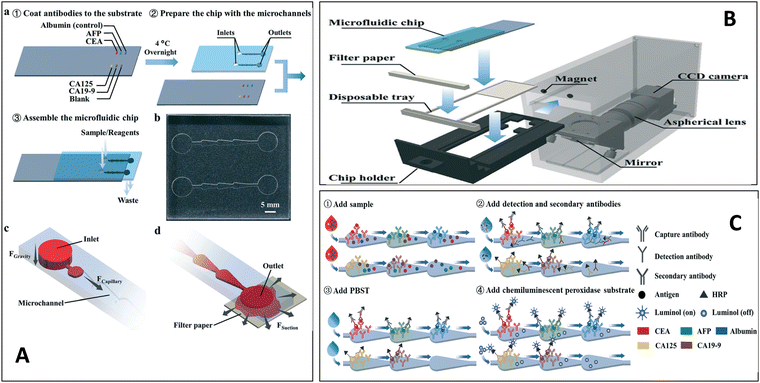 | ||
| Fig. 3 (A) Basic design & assembly of the chip (a). Microfluidic chip (b). Inlet & outlet of the chip showing the capillary action (c) and (d). (B) Schematic of the POC chip for cancer detection. (C) Detection process of the assay for different cancer biomarkers. Reproduced from ref. 42 with permission from the Royal Society of Chemistry. | ||
Bio-printing models are also being explored by many cancer researchers as patient-derived cancer cells with extracellular matrix proteins and growth factors can be used in the same platform for personalized cancer therapy. Recently, glioblastoma (GBM), which is the most common aggressive form of cancer affecting the brain, has been investigated by oncologists for drug screening. Bio-printed models have been developed to customize treatments for glioblastoma drug responses of glioma cells to understand tumor formation. A lot of researchers worked on a 3D bioprinter model to develop a glioblastoma-on-a-chip model to enable the evaluation of treatment responses for individual patients whose brain tumors are resistant to standard chemoradiotherapy.45,46
Organ-on-a-chip
Organ-on-a-chip (OC) technology is an advanced version of lab-on-chip (LoC) which imitates organ functions to test and evaluate the human body functions under real physiological conditions.47 This has attracted a great deal of attention in recent years as OC has reduced the huge expenditure involved in drug testing systems. The OC has multiple applications in medical technology for cell-based analysis such as miniaturized total analysis systems, cell patterning in microchannels, cell handling in microchannels, and cell culture in microchannels for drug testing. Currently, these systems are being explored for regenerative medicine, cancer immunotherapy, and cancer drug therapy in single and multi-organ systems.48,49Dornhof et al. designed an OC platform to monitor the metabolites of cancer cells for a drug effect study.50 They used triple negative breast cancer stem cells (BCSC1) to develop into tumor organoids in a heterogeneous spheroid culture to understand the metabolic parameters towards developing personalized medicine for cancer patients. They carried out the study in breast cancer cells to measure various metabolite parameters (oxygen, glucose, lactate monitoring) and further investigated the effect of chemotherapeutic drug doxorubicin on the cancer cells. The basic design of the chip, the spheroid formation in the organ on a chip and the results are shown in Fig. 4(A)–(C). Three distinct biosensors were strategically placed to monitor metabolite levels throughout a week-long experiment. This work provides a simple way of evaluating the basic body parameters of cancer cells for drug screening. Similarly, Yang et al. developed a lung-on-a-chip platform with a poly(lactic-co-glycolic acid) (PLGA) electrospinning nanofiber membrane as the chip substrate and cell scaffold to investigate the drug effect on human non-small cell lung cancer cells (A549) and human fetal lung fibroblast (HFL1) cells.51 They also reported the effect of drugs such as gefitinib, an epidermal growth factor receptor (EGFR)-targeted anti-tumor drug, on the above cell line. Furthermore, the OC can test various anti-cancer drugs for personalized cancer therapy development. This would bring more fruitful outcomes for precise drug selection and targeted drug therapy management in cancer research.
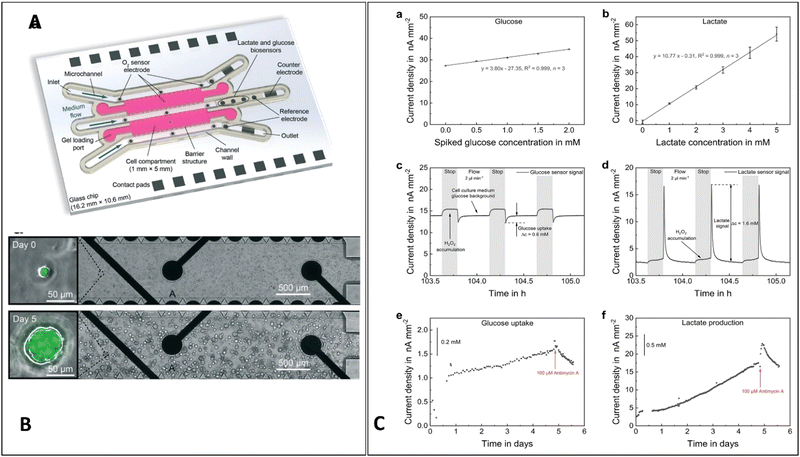 | ||
| Fig. 4 (A) The various working parts of the organ on a chip along with sensor position to measure the metabolites of breast cancer cells (BCSC1). (B) Fluorescence images of single breast cancer cells and tumor spheroid formation after 5 days of experiment and (C) the calibration curves of glucose and lactate (a) and (c), glucose and lactate sensor signal during the experiment (b) and (c) and glucose uptake (e) and (f) lactate production during cell culture and their change upon addition of 100 μM antimycin A. Reproduced from ref. 48 with permission from the Royal Society of Chemistry. | ||
Currently, researchers are developing cancer on a chip or tumor-on-chip systems to reproduce the tumor microenvironment such as biochemical gradients and niche factors, dynamic cell-to-cell and cell-to-matrix interactions, and complex tissue structures composed of tumor and stromal cells.52 These new types of OC can produce the dynamic microenvironment of a tumor and can trace the cancer progression in real-time. Tumors have a heterogeneous structure consisting of many types of cells such as fibroblasts, immune cells, and cancer stem cells. Therefore, for understanding the tumor microenvironment in a physiological system, OC can bring a revolution for exploring tumor growth (simulation of tumor growth and expansion, and progression of the disease including epithelial–mesenchymal transition (EMT)).
Multiple organ-on-a-chip can be merged to construct body-on-a-chip models that are capable of simulating multiorgan interactions for developing multisystem interactions. This multi-organ system has numerous advantages in carrying out different sets of experiments in a single platform to understand the physiological conditions of the human body.48 Jang et al. reported cross-species organ on a chip (liver–chip) using rat, dog, and human cells to investigate the diverse phenotypes of liver toxicity.53 This multispecies liver–chip has opened a new avenue of platforms for the prediction of liver toxicity.
Currently, the concept of 4D bio-printing based OC has been gaining popularity as time has been introduced in 3D printing to investigate the effect of an external stimulus (electric field, magnetic field, light source, change in pH, etc.) on the static organoids that can change shape or functionality.54 This 4D bio-printing is promising for drug screening but it needs a more rigorous approach. However, one of the fundamental goals of OC is to develop a full body on chip platform for a disease specific investigation for personalized therapy. Therefore, the future looks very interesting for cancer related research in the field of OC.
Wearables
Wearable devices are gaining popularity in cancer diagnostics to evaluate physical activity by observing or tracking body parameters.55 The most common factors that are measured during cancer treatment are physical activity, oxygen level, pulse, skin temperature, sleeping pattern, etc. to decide the clinical outcomes as well as post-treatment observations.56 There are reports that physical exercise may result in beneficial changes in the circulating level of insulin, insulin-related pathways, inflammation, and immunity.57 The self-assessment of physical activity through wearable devices is being accepted as clinical data in many complex diseases such as cancer for diagnostics as well as post-treatment.58 Therefore, the collection of activity data using wearable devices has been demonstrated to be feasible and acceptable among cancer patients in active treatment.59Currently, wearable devices are reasonably priced, comfortable, and convenient to wear continuously for long-term data collection whereas regular hospital instruments are heavy, complicated, uncomfortable, and not user-friendly in terms of acquiring data.60 Another major improvement in wearable gadgets is that frequent syncing of data to cloud-based servers or hospital servers provides real-time monitoring and remote monitoring of the patient. Thus, wearable devices provide an uninterrupted way of collecting physical activity data and availing it to researchers or clinicians for evaluating the patient's conditions.
Physical activity is associated with the prevention and improvement of chronic conditions in cancer patients’ post-treatment.61 It also reduces the risk of disease progression and mortality rate and can highlight early symptoms of any further complications. It is also reported that physical activity can reduce cognitive dysfunction and functional limitations and improve the mental health and quality of life of a patient.62
Cancer patients go through rigorous treatment and follow a strict procedure for successful treatment of a disease. Therefore, they require precise information on every single step of the treatment strategy for evaluation of human body function and constant monitoring of body vitals to decide on future treatment. Furthermore, after treatment of cancer patients there is always a chance of recurrence of the disease, and it is not possible for doctors or clinicians to investigate this closely as patients spend their time at home. However, using the current wearable devices to track dynamic changes in the human body and provide real-time monitoring of the patient's condition for follow-up treatment is very useful. By monitoring and recording body vitals (physical activity, oxygen level, body temperature, etc.), one can determine the health status of the individual. Patients who have undergone radiation therapy and lead inactive lifestyles, as measured by wearable devices, are experiencing elevated health risks, as indicated by reports. Higher step counts indicate a more active life and this has a great impact on the lives of post-treatment cancer patients.
Gresham, G. et al. reported the clinical outcome of advanced cancer patients by monitoring their physical activity using wearable devices.63 He determined that higher fitbit-recorded step counts of cancer patients indicated a better health performance and reduced the chance of patient hospitalization. Similarly, coughlin, et al. also reported that the use of consumer wearable devices is beneficial to promote physical activity among breast, prostate, and colorectal cancer survivors.64
On the other hand, the lower Fitbit-recorded step counts of 39 lung cancer patients indicated poor quality of life as they were associated with patient depression due to a lack of physical activity.65 Hence, remote real-time monitoring of activity data of cancer patients is very conducive for doctors as well as for patients to predict clinical and patient-reported outcomes while minimizing risk factors. This can be further improved by integrating AI and IOT based tools for real time consultation and diagnosis to avoid emergency situations.
Artificial intelligence (AI) and internet-of-things (IoT)
Ever since AI and ML have replaced the traditional statistical methods in cancer research for diagnostics, prognostics and predictive analysis, there has been an increase in the number of research papers published due to the high accuracy of the data interpretation.18,66,67Furthermore, IoT-based predictive modeling and low-cost sensors have been developed to provide real-time solutions to screen and detect cancer in its early stages.68–71 Patients from remote villages have shown reluctance to visit specialized centers due to the high cost of travel and the expenditure involved in cancer treatment. Due to the increase in the number of cancer patients, resources are limited for screening, and therefore, treatment is delayed further for many individuals. As a result, most of the population does not have access to screening facilities. So, a simplistic solution to the above-mentioned problem is to provide an online consultation facility. IoT-based technology would collect data from cancer patients through real-time monitoring using wearable devices and portable sensors and transmit the data to medical experts.72 In this way, the patient is connected to an oncologist who can monitor and analyze the health condition of the patient. The oncologist would then prepare a complete history of the patient for better diagnosis of cancer patients from the depository of electronic health records (EHR) and digital patient records from smart hospitals for cancer management.73Fig. 5 depicts a schematic illustration of the POC-based data collection and analysis by AI & ML tools in a secure way, which are shared through IOT for digital healthcare application in smart hospitals by accessing EHR.
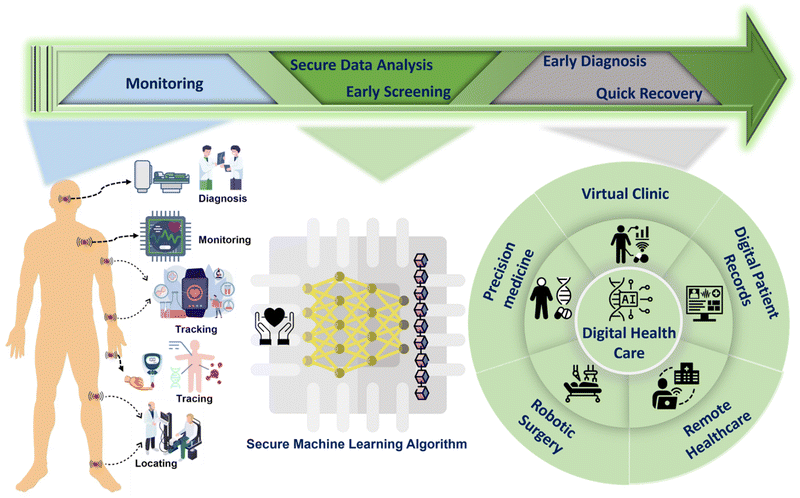 | ||
| Fig. 5 Schematic illustration of the POC-based data collection, analysis by AI & ML, and EHR shared through IOT for smart hospital application. | ||
In the last decade, data analysis has opened huge scope for cancer disease management.74 The FDA has approved the use of AI for clinical data analysis of cancer.75 Researchers are developing AI algorithms for the screening, diagnosis, treatment, and determination of various cancers.76 Furthermore, the tumor microenvironment, tumor heterogeneity, cancer genomics, assessment of biomarkers, and the effectiveness of new vaccines and drugs, etc. have benefitted from AI algorithms.77 AI-based computer programs have provided critical information to screen the mammogram images of breast cancer patients and predict the risk factor for disease recurrence.78 There are several clinical applications of AI for the development of new anti-cancer drugs and cancer vaccines to reduce the expenditure of clinical trials. Furthermore, AI has been integrated with some well-known imaging techniques. AI-based image processing tools and techniques have been developed for breast, lung, and prostate cancers and have been fruitful in predicting disease outcomes. AI-based information is validated with wet lab experiments to provide more robust results. Therefore, there is plenty of scope for AI to lead in clinical settings for the better management of cancer patients and to provide decisive steps in radiology and pathology.
Current challenges
POC has enormous potential to transform cancer management through digital technology. Cancer management can be fruitful using a POC as it can share real-time data of patients and healthy individuals to prepare for the disease. Also, for emergency cases, using the initial health data of a patient could save lives due to early diagnosis of conditions. However, the majority of the population is not aware of the data breaching and privacy policies regarding their health parameters obtained from these portable instruments. Fair data policy and stringent laws regarding the breaching of data can be implemented to stop any misuse of a patient's clinical information.AI-integrated POC devices can improve treatment efficacy and healthcare by combining neural networks which can be interlinked with wearable devices for large-scale screening and monitoring of patients.79 In this way, we can track the health records of a patient through IoT and IoMT devices to understand the disease conditions for appropriate diagnosis.80
One of the main challenges in disease diagnosis is to develop a sensitive, easy-to-use, cost-effective POC system to differentiate between false-negative and false-positive results. AI-enabled systems can reduce the error percentage by reducing human bias. Furthermore, handling of large data is very problematic for humans but can be easily processed by AI-based systems to produce accurate results for diagnostics.
Clinicians have benefited from providing a suitable clinical decision to make efficient and efficacious treatment decisions with the help of AI and IoT, however, it is very important to keep an eye on patient data safety.81 Therefore, the implementation of an AI model in the healthcare sector should have strict laws regarding the handling of healthcare records of patients.82 Similarly, clinicians have used AI technology for processing and analysis of cancer images for accurate detection, characterization, and monitoring of cancers, while bearing in mind the privacy issues regarding patient data.83
Calibrating a device is very important for any measurement procedure in order to obtain accurate results. There are many kinds of errors that appear during data acquisition and data processing. Typical causes of systematic error include observational error, imperfect instrument calibration, and electronic interferences. Some of the errors can be removed by suitably configuring the system. Systematic errors arise due to carelessness or overuse of an instrument which can easily be eliminated by re-calibrating the instrument. However, errors always appear in the system which cannot be eliminated. Therefore, calibration of the device will compensate for any errors due to faulty equipment or a flawed experimental design which can be improved further with the help of AI and IOT.
Therefore, POC can revolutionize the healthcare system and improve the health of the population.
Conclusions and future directions
Early detection and monitoring of tumors can result in more effective treatment when using POC based systems. POC testing provides rapid onsite results to oncologists, but more fundamental and advanced research studies are required to reduce the death rate of cancer. However, the future of cancer research is very encouraging. POC systems have transformed cancer research towards the development of smarter tools. POC instruments are expected to become more advanced, portable, and affordable as technology develops, making them essential for early cancer detection, monitoring, and personalized treatment approaches in both developed and poor nations. By enabling access to quick and precise cancer diagnostics for individual patients for personalized therapies, these technologies will be crucial in reducing death rates. Furthermore, POC systems can provide real-time monitoring of treatment responses, leading to more personalized and effective therapies. Additionally, POC applications are ready to effortlessly interact with cutting-edge disciplines like genomics and artificial intelligence, enabling interventions that are more precise and customised. POC applications will become a cornerstone in coming years as a result of collaborative efforts between researchers, healthcare providers, and technology companies that will spur innovation and ultimately improve cancer outcomes for patients throughout the world. The direction of cancer research has shown promising results in four sectors: gene editing (CRISPR/Cas9), immunotherapy, precision medicine, and human microbiome.84,85 We have depicted the above concept in Fig. 6 showing the promising research areas for cancer management. CRISPR/Cas9 technology can manipulate human DNA by editing any target gene to remove any unwanted mutation. As an illustration, the elimination of specific genes from T cells, in combination with immune checkpoint inhibitors, can prevent an excessive or harmful immune response against the body's own tissues. Another milestone that has been achieved in cancer is the immunotherapy approach in which immune cells like T cells can be genetically engineered for the human body to specially target cancer antigens (CAR-T cell therapy).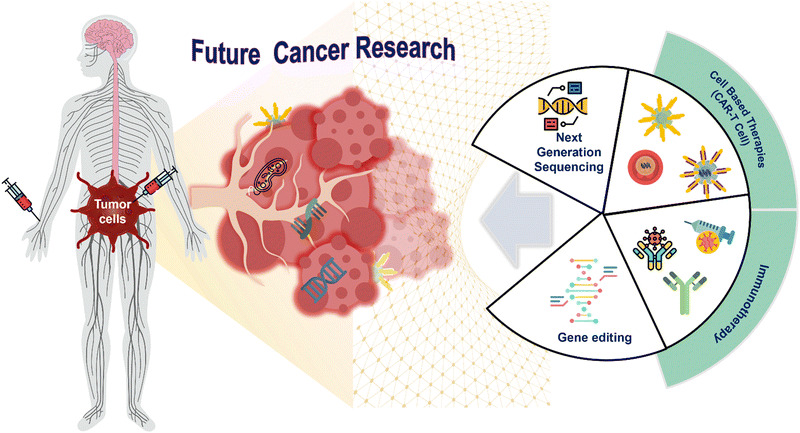 | ||
| Fig. 6 The illustration of future technologies in cancer research towards developing a smarter digital healthcare system for better outcomes in cancer disease treatment. | ||
Precision medicine has achieved breakthroughs in therapeutic vaccines for each tumor for personalized treatment of tumors in some cancer patients. Also, AI and ML technologies have been used to investigate genomic, proteomic, and clinical data for digital pathology and radiology for understanding cancer as a system. This research required a combination of teams to collect and evaluate the data to model the biology of cancer systems. This research will significantly improve understanding of the evaluation of tumors, possible causes of tumor heterogeneity and provide better diagnostic approaches for a productive outcome in precision medicine.
Author contributions
This manuscript was written through contributions of all authors. All authors have given approval to the final version of the manuscript.Conflicts of interest
There are no conflicts of interest among the authors.Acknowledgements
The authors want to acknowledge their respective institutions for their support.References
- L. Wu and X. Qu, Chem. Soc. Rev., 2015, 44, 2963–2997 RSC.
- J. E. Visvader, Nature, 2011, 469, 314–322 CrossRef CAS PubMed.
- C. Blanpain, Nat. Cell Biol., 2013, 15, 126–134 CrossRef CAS PubMed.
- R. C. Fitzgerald, A. C. Antoniou, L. Fruk and N. Rosenfeld, Nat. Med., 2022, 28, 666–677 CrossRef CAS PubMed.
- P. Vineis and C. P. Wild, Lancet, 2014, 383, 549–557 CrossRef PubMed.
- D. Kumar, I. Mutreja and A. Kaushik, J. Nanotheranostics, 2023, 4, 150–170 CrossRef.
- V. Chaudhary, R. Chowdhury, P. Thukral, D. Pathania, S. Saklani, S. Rustagi, A. Gautam, Y. K. Mishra, P. Singh and A. Kaushik, Environ. Res., 2023, 115933 CrossRef CAS PubMed.
- B. Ortiz-Casas, A. Galdámez-Martínez, J. Gutiérrez-Flores, A. B. Ibañez, P. K. Panda, G. Santana, H. A. de la Vega, M. Suar, C. G. Rodelo and A. Kaushik, Mater. Today, 2021, 50, 533–569 CrossRef CAS.
- K. R. Khondakar, S. Dey, A. Wuethrich, A. A. I. Sina and M. Trau, Acc. Chem. Res., 2019, 52, 2113–2123 CrossRef CAS PubMed.
- W. L. Bi, A. Hosny, M. B. Schabath, M. L. Giger, N. J. Birkbak, A. Mehrtash, T. Allison, O. Arnaout, C. Abbosh and I. F. Dunn, Ca-Cancer J. Clin., 2019, 69, 127–157 CrossRef PubMed.
- A. Zuchowska and S. Skorupska, Organs-on-a-Chip, 2022, 4, 100014 CrossRef CAS.
- L. Syedmoradi, M. L. Norton and K. Omidfar, Talanta, 2021, 225, 122002 CrossRef CAS PubMed.
- K. K. Reza, S. Dey, A. Wuethrich, A. A. I. Sina, D. Korbie, Y. Wang and M. Trau, Nanoscale, 2018, 10, 18482–18491 RSC.
- J. Tu, R. M. Torrente-Rodríguez, M. Wang and W. Gao, Adv. Funct. Mater., 2020, 30, 1906713 CrossRef CAS.
- S.-M. Yang, S. Lv, W. Zhang and Y. Cui, Sensors, 2022, 22, 1620 CrossRef CAS PubMed.
- Z. Li, J. Hui, P. Yang and H. Mao, Biosensors, 2022, 12, 370 CrossRef CAS PubMed.
- A. E. Chung, R. E. Jensen and E. M. Basch, J. Oncol. Pharm. Pract., 2016, 12, 863 CrossRef PubMed.
- S. M. McKinney, M. Sieniek, V. Godbole, J. Godwin, N. Antropova, H. Ashrafian, T. Back, M. Chesus, G. S. Corrado and A. Darzi, Nature, 2020, 577, 89–94 CrossRef CAS PubMed.
- S. Dey, R. Vaidyanathan, K. K. Reza, J. Wang, Y. Wang, H. J. Nel, S.-C. Law, J. Tyler, J. Rossjohn and H. H. Reid, Sens. Actuators, B, 2019, 284, 281–288 CrossRef CAS.
- K. K. Reza, A. A. I. Sina, A. Wuethrich, Y. S. Grewal, C. B. Howard, D. Korbie and M. Trau, Biosens. Bioelectron., 2019, 126, 178–186 CrossRef CAS PubMed.
- R. C. Larson and M. V. Maus, Nat. Rev. Cancer, 2021, 21, 145–161 CrossRef CAS PubMed.
- R. Baghban, L. Roshangar, R. Jahanban-Esfahlan, K. Seidi, A. Ebrahimi-Kalan, M. Jaymand, S. Kolahian, T. Javaheri and P. Zare, Cell Commun. Signaling, 2020, 18, 1–19 CrossRef PubMed.
- K. K. Reza, S. Dey, A. Wuethrich, J. Wang, A. Behren, F. Antaw, Y. Wang, A. A. I. Sina and M. Trau, ACS Nano, 2021, 15, 11231–11243 CrossRef CAS PubMed.
- B. Lumbreras, L. A. Parker, J. P. Caballero-Romeu, L. Gómez-Pérez, M. Puig-García, M. López-Garrigós, N. García and I. Hernández-Aguado, Cancers, 2023, 15, 261 CrossRef PubMed.
- V. K. Sarhadi and G. Armengol, Biomolecules, 2022, 12, 1021 CrossRef CAS PubMed.
- K. R. Khondakar, A. K. Kaushik and K. M. Reza, in Nanotechnology in Cancer Management, ed. K. R. Khondakar and A. K. Kaushik, Elsevier, 2021, pp. 35–41 DOI:10.1016/B978-0-12-818154-6.00004-4.
- N. Goossens, S. Nakagawa, X. Sun and Y. Hoshida, Translational cancer research, 2015, 4, 256 CAS.
- P. Costa-Pinheiro, D. Montezuma, R. Henrique and C. Jerónimo, Epigenomics, 2015, 7, 1003–1015 CrossRef CAS PubMed.
- S. M. Hanash, C. S. Baik and O. Kallioniemi, Nat. Rev. Clin. Oncol., 2011, 8, 142–150 CrossRef PubMed.
- B. Heidt, W. F. Siqueira, K. Eersels, H. Diliën, B. van Grinsven, R. T. Fujiwara and T. J. Cleij, Biosensors, 2020, 10, 133 CrossRef PubMed.
- R. D. Allert, F. Bruckmaier, N. R. Neuling, F. A. Freire-Moschovitis, K. S. Liu, C. Schrepel, P. Schätzle, P. Knittel, M. Hermans and D. B. Bucher, Lab Chip, 2022, 22, 4831–4840 RSC.
- N.-B. Mincu, V. Lazar, D. Stan, C. M. Mihailescu, R. Iosub and A. L. Mateescu, Diagnostics, 2020, 10, 517 CrossRef CAS PubMed.
- S. Singh, J. Wang and S. Cinti, ECS Sens. Plus, 2022, 1, 023401 CrossRef.
- R. D. Crapnell, A. G.-M. Ferrari, N. C. Dempsey and C. E. Banks, Sens. Diagn., 2022, 1, 405–428 RSC.
- A. G.-M. Ferrari, S. J. Rowley-Neale and C. E. Banks, Talanta Open, 2021, 3, 100032 CrossRef.
- D. C. Ferreira, M. R. Batistuti, B. Bachour and M. Mulato, Bioelectrochemistry, 2021, 137, 107586 CrossRef CAS PubMed.
- B. Selvakumar and A. Kathiravan, Talanta, 2021, 235, 122733 CrossRef CAS PubMed.
- Y. Yuan, B. Liu, T. Wang, N. Li, Z. Zhang and H. Zhang, TrAC, Trends Anal. Chem., 2022, 116816 CrossRef CAS.
- B. Asci Erkocyigit, O. Ozufuklar, A. Yardim, E. Guler Celik and S. Timur, Biosensors, 2023, 13, 387 CrossRef CAS PubMed.
- G. Ebrahimi, P. S. Pakchin, A. Mota, H. Omidian and Y. Omidi, Talanta, 2023, 124370 CrossRef CAS PubMed.
- S. C G, C. H. Ravikumar and R. G. Balakrishna, Chem. Eng. J., 2023, 464, 142581 CrossRef CAS.
- T.-H. Ulep, R. Zenhausern, A. Gonzales, D. S. Knoff, P. A. L. Diaz, J. E. Castro and J.-Y. Yoon, Biosens. Bioelectron., 2020, 153, 112042 CrossRef CAS PubMed.
- X. Zhou, W. Zhu, M. Nowicki, S. Miao, H. Cui, B. Holmes, R. I. Glazer and L. G. Zhang, ACS Appl. Mater. Interfaces, 2016, 8, 30017–30026 CrossRef CAS PubMed.
- B. Dai, C. Yin, J. Wu, W. Li, L. Zheng, F. Lin, X. Han, Y. Fu, D. Zhang and S. Zhuang, Lab Chip, 2021, 21, 143–153 RSC.
- N. Gomez-Roman and A. J. Chalmers, Nat. Biomed. Eng., 2019, 3, 498–499 CrossRef PubMed.
- H.-G. Yi, Y. H. Jeong, Y. Kim, Y.-J. Choi, H. E. Moon, S. H. Park, K. S. Kang, M. Bae, J. Jang and H. Youn, Nat. Biomed. Eng., 2019, 3, 509–519 CrossRef CAS PubMed.
- F. Duzagac, G. Saorin, L. Memeo, V. Canzonieri and F. Rizzolio, Cancers, 2021, 13, 737 CrossRef PubMed.
- S. E. Park, A. Georgescu and D. Huh, Science, 2019, 364, 960–965 CrossRef CAS PubMed.
- W. Sun, Z. Luo, J. Lee, H. J. Kim, K. Lee, P. Tebon, Y. Feng, M. R. Dokmeci, S. Sengupta and A. Khademhosseini, Adv. Healthcare Mater., 2019, 8, 1801363 CrossRef PubMed.
- J. Dornhof, J. Kieninger, H. Muralidharan, J. Maurer, G. A. Urban and A. Weltin, Lab Chip, 2022, 22, 225–239 RSC.
- X. Yang, K. Li, X. Zhang, C. Liu, B. Guo, W. Wen and X. Gao, Lab Chip, 2018, 18, 486–495 RSC.
- N. Del Piccolo, V. S. Shirure, Y. Bi, S. P. Goedegebuure, S. Gholami, C. C. Hughes, R. C. Fields and S. C. George, Adv. Drug Delivery Rev., 2021, 175, 113798 CrossRef CAS PubMed.
- K.-J. Jang, M. A. Otieno, J. Ronxhi, H.-K. Lim, L. Ewart, K. R. Kodella, D. B. Petropolis, G. Kulkarni, J. E. Rubins and D. Conegliano, Sci. Transl. Med., 2019, 11, eaax5516 CrossRef CAS PubMed.
- N. Tabatabaei Rezaei, H. Kumar, H. Liu, S. S. Lee, S. S. Park and K. Kim, Adv. Healthcare Mater., 2023, 2203172 CrossRef CAS PubMed.
- E. L. Van Blarigan, S. A. Kenfield, L. Tantum, L. A. Cadmus-Bertram, P. R. Carroll and J. M. Chan, JMIR cancer, 2017, 3, e6935 CrossRef PubMed.
- J. A. Schrack, G. Gresham and A. A. Wanigatunga, Mol. Case Stud., 2017, 3, a001933 CrossRef PubMed.
- R. Ballard-Barbash, C. M. Friedenreich, K. S. Courneya, S. M. Siddiqi, A. McTiernan and C. M. Alfano, J. Natl. Cancer Inst., 2012, 104, 815–840 CrossRef PubMed.
- K. R. Khondakar and A. Kaushik, Biosensors, 2023, 13, 62 CrossRef PubMed.
- T. Miyaji, T. Kawaguchi, K. Azuma, S. Suzuki, Y. Sano, M. Akatsu, A. Torii, T. Kamimura, Y. Ozawa and A. Tsuchida, Supp. Care Cancer, 2020, 28, 5953–5961 CrossRef PubMed.
- C. A. Low, NPJ Digit. Med., 2020, 3, 1–7 CrossRef PubMed.
- J.-M. Wu, T.-W. Ho, Y.-T. Chang, C. Hsu, C. J. Tsai, F. Lai and M.-T. Lin, JMIR Health Health, 2019, 7, e11989 Search PubMed.
- D. E. Warburton, C. W. Nicol and S. S. Bredin, Cmaj, 2006, 174, 801–809 Search PubMed.
- G. Gresham, A. E. Hendifar, B. Spiegel, E. Neeman, R. Tuli, B. Rimel, R. A. Figlin, C. L. Meinert, S. Piantadosi and A. M. Shinde, NPJ Digit. Med., 2018, 1, 1–8 CrossRef PubMed.
- S. S. Coughlin, L. S. Caplan and R. Stone, J. Cancer Surviv., 2020, 14, 386–392 CrossRef PubMed.
- B. C. Bade, M. C. Brooks, S. B. Nietert, A. Ulmer, D. D. Thomas, P. J. Nietert, J. B. Scott and G. A. Silvestri, Integr. Cancer Ther., 2018, 17, 73–79 CrossRef PubMed.
- S. Huang, J. Yang, S. Fong and Q. Zhao, Cancer Lett., 2020, 471, 61–71 CrossRef CAS PubMed.
- B. Bhinder, C. Gilvary, N. S. Madhukar and O. Elemento, Cancer Discovery, 2021, 11, 900–915 CrossRef CAS PubMed.
- S. Banka, I. Madan and S. Saranya, Int. J. Appl. Eng. Res., 2018, 13, 11984–11989 Search PubMed.
- A. Onasanya and M. Elshakankiri, Wireless Networks, 2021, 27, 4297–4312 CrossRef.
- P. Manickam, S. A. Mariappan, S. M. Murugesan, S. Hansda, A. Kaushik, R. Shinde and S. Thipperudraswamy, Biosensors, 2022, 12, 562 CrossRef CAS PubMed.
- V. Chaudhary, A. K. Kaushik, H. Furukawa and A. Khosla, ECS Sens. Plus, 2022, 1, 013601 CrossRef.
- I. Jayatilleka and M. N. Halgamuge, Real-time data analytics for large scale sensor data, Elsevier, 2020, pp. 1–35 Search PubMed.
- E. Kim, S. M. Rubinstein, K. T. Nead, A. P. Wojcieszynski, P. E. Gabriel and J. L. Warner, Semin Radiat Oncol., 2019, 29, 354–361 CrossRef PubMed.
- T. M. Ghazal, M. K. Hasan, M. T. Alshurideh, H. M. Alzoubi, M. Ahmad, S. S. Akbar, B. Al Kurdi and I. A. Akour, Future Internet, 2021, 13, 218 CrossRef.
- C. Luchini, A. Pea and A. Scarpa, Br. J. Cancer, 2022, 126, 4–9 CrossRef PubMed.
- D. Patel, Y. Shah, N. Thakkar, K. Shah and M. Shah, Augment. Hum. Res., 2020, 5, 1–10 CrossRef.
- O. Adir, M. Poley, G. Chen, S. Froim, N. Krinsky, J. Shklover, J. Shainsky-Roitman, T. Lammers and A. Schroeder, Adv. Mater., 2020, 32, 1901989 CrossRef CAS PubMed.
- S. M. Shah, R. A. Khan, S. Arif and U. Sajid, arXiv, 2021, preprint, arXiv:2110.00942 DOI:10.48550/arXiv:2110.00942.
- A. Parihar, A. Singhal, N. Kumar, R. Khan, M. A. Khan and A. K. Srivastava, Nano-Micro Lett., 2022, 14, 100 CrossRef CAS PubMed.
- P. Ranjan, A. Singhal, M. A. Sadique, S. Yadav, A. Parihar and R. Khan, Biosensor Based Advanced Cancer Diagnostics, Elsevier, 2022, pp. 395–410 Search PubMed.
- R. Kaul, C. Ossai, A. R. M. Forkan, P. P. Jayaraman, J. Zelcer, S. Vaughan and N. Wickramasinghe, Wiley Interdiscip. Rev.: Data Min. Knowl. Discov., 2023, 13, e1480 Search PubMed.
- R. O. Ogundokun, S. Misra, M. Douglas, R. Damaševičius and R. Maskeliūnas, Future Internet, 2022, 14, 153 CrossRef.
- M. J. Iqbal, Z. Javed, H. Sadia, I. A. Qureshi, A. Irshad, R. Ahmed, K. Malik, S. Raza, A. Abbas and R. Pezzani, Cancer Cell Int., 2021, 21, 1–11 CrossRef PubMed.
- C. Jobin, Science, 2018, 359, 32–34 CrossRef CAS PubMed.
- S. Mukherjee, Cancer Biother. Radiopharm., 2019, 34, 487–497 CrossRef PubMed.
| This journal is © The Royal Society of Chemistry 2023 |





